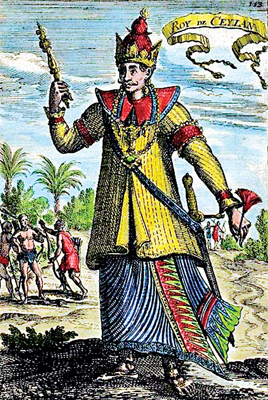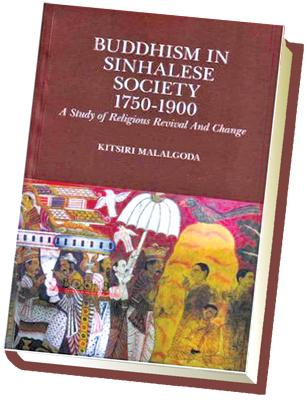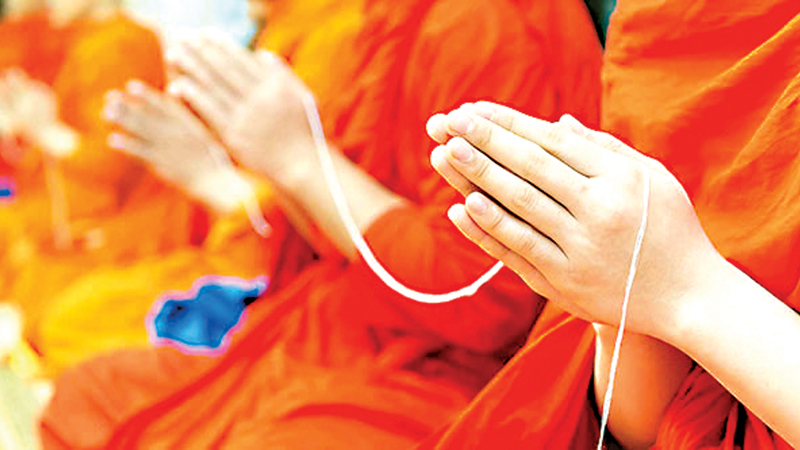It is by now well established that for any religious faith to be developed and accepted by the generality of the population, it has to have State backing. “Convert the king and the population will follow suit,” had been a belief among missionaries other than those who chose to target the poor mainly.
At any rate, experience says that State power is essential for any faith to develop its doctrine, sustain it and ensure fealty to it. Conversely, any weakening of the State due to economic distress, alien hegemony, wars or economic distress will have a deleterious effect on the faith and its following.
 The role of the State in the growth or decline of Buddhism in Sri Lanka from the days of the kings to those of the colonial powers is described by Prof. Kitisiri Malalgoda, Professor of Sociology in the University of Auckland in his book: “Buddhism in Sinhalese Society 1750-1900: A Study of Religious Revival and Change” (Tambapani Academic Publishers, Colombo, 2023).
The role of the State in the growth or decline of Buddhism in Sri Lanka from the days of the kings to those of the colonial powers is described by Prof. Kitisiri Malalgoda, Professor of Sociology in the University of Auckland in his book: “Buddhism in Sinhalese Society 1750-1900: A Study of Religious Revival and Change” (Tambapani Academic Publishers, Colombo, 2023).
It was due to the patronage of Emperor Asoka (268 – 232 BC) that Buddhism spread across the length and breadth of India. In Sri Lanka, the first convert was king Tissa (250-210 BC) and because of that Buddhism began to be accepted in the island. Prof. Malalgoda describes Tissa’s conversion as an event of great importance in the religious and political history of Sri Lanka.
Tissa’s rule also signified the beginning of the culture of kingship in Sri Lanka. Political centralization and the ritual, pomp and ceremony surrounding kingship came into vogue. The Indian tradition of performing Abhiseka or consecration was adopted as a rite of passage for kingship in the island.
Tissa and his successors also assumed the Mauryan (Asokan) title of Devanampiya (beloved of the Gods). Thus kingship combined the political and the spiritual to make it a powerful institution, which enabled the propagation of Buddhism.
Prof. Malalgoda says that the institution of kingship and its adoption of Buddhism enabled the formation of large and integrated territorial groups bound by a single ideology (Buddhism). Before this, territorial units were small, scattered and unconnected to a single framework. The belief systems were many and diverse. There was no ideological unity. But kingship and one faith, Buddhism, enabled State formation in Sri Lanka.
Be that as it may, there existed a dichotomy in religious beliefs and practices, he said. People living in isolated village communities were heir to a variety of beliefs and practices of diverse origin and these continued to exist. Prof. Malalgoda calls these “Little Traditions” and Buddhism, the “Great Tradition.”
Recognition
Notwithstanding the practice of Little Traditions, people supported the Great Tradition of Buddhism and practised it to the extent possible. They venerated the symbols of the Great Tradition like the Bodhi tree, the Chetiyas (where the corporeal relics of the Buddha were kept) and the Tooth Relic.
The Tooth Relic was brought to Sri Lanka in the reign of King Sirimeghavanna (304–332 AD) with much pomp and ceremony. Later, it became the symbol of sovereignty. One who possessed it was the sovereign. The Tooth Relic was the centre and symbol of Sinhalese Buddhist polity.
 The conspicuous role played by the King himself in ceremonies around the Tooth Relic was ample evidence of its political cum ideological significance. These ceremonies around a particular sacred object were necessary for Sinhalese society to express their collective identity apart from their particular identities.
The conspicuous role played by the King himself in ceremonies around the Tooth Relic was ample evidence of its political cum ideological significance. These ceremonies around a particular sacred object were necessary for Sinhalese society to express their collective identity apart from their particular identities.
Did these rituals and ceremonies clash with the pristine ideas of Buddhism? Did not Buddhism emphasise renunciation rather than pompous display? According to Prof. Malalgoda there was no contradiction as Sinhalese Buddhist society had a subordinate ideology wherein merit could be garnered by performing meritorious acts which included the performance of rituals (barring a few which were deemed to be evil). The belief was that meritorious deeds would give the performer a better birth in the cycle of births and deaths perfectly legitimate goals.
Giving alms to the Sangha was one of the chief meritorious deeds. The Sangha was called the Punnya Khetta (Field of Merit) sowing seeds which would enable one to reap a rich harvest of merit and ensure a better life in the births to come. One way of serving the Sangha was to assign them lands so that they could live on their produce. The kings did this to earn merit.
There was a distinction between Pariyatti (the theoretical teachings of the Buddha) and Patipatti (practice of the Buddha’s teachings). Some members of the Sangha took to renunciation and others taught the theory and became guides to societies. There was a distinction between Aranyavasis and Gamavasis, the former lived outside society and the latter within society. The Gamavasis became society’s intellectuals and therefore indispensable.
The learning of Pali enabled Sri Lankan bhikkhus to communicate with Theravada bhikkhus in other countries. The Sutta Pitaka was translated into Sinhala under the patronage of King Buddhadasa (337-365 AD) to popularise the doctrine.
Religious practices
Plebeian religious practices and beliefs were not discouraged as they served a felt need. But those entertaining these beliefs accepted pristine Buddhism and its ideals as being superior. They knew that the Buddha did not grant favours and that for favours they should worship other local or Hindu deities and use charms and magic etc. But they knew that, powerful as these gods might be, they were subordinate to the Buddha. Their task was to safeguard Buddhism.
The Buddha was not a saviour but a Devatideva (Deity of deities). The gods derived their power (Varan) from the Devatideva, the Buddha.
When “evil sciences”” like astrology became too widespread or when bhikkhus were breaking the Vinaya (their code of conduct), the kings used to initiate regulative acts known as Dhamma Kamma performed by the Sangha. When performed without royal authority Dhamma Kamma would not be productive. The only magical practice that was allowed in Buddhism proper, was the Paritta (protection) performed to mitigate public calamities or private distress.
When the Portuguese established their hegemony in the maritime provinces in the 16th Century, and the Dutch took over from them in the 17 th Century, Buddhism was thrown into a crisis as these two foreign powers were inflicting Catholicism and Protestantism on Buddhists.
In this period, Buddhism lacked State patronage except in Kandy. Buddhists had lost the Kelaniya temple as the Kotte king Dharmapala, a Catholic convert, had gifted it to the Portuguese who passed it on to the Dutch later.
The Dutch used various coercive ways to convert Buddhists to Calvinism. They made baptism and Christian marriage compulsory. Conversion was mandatory to get a government job. All schools were religious schools.
But to their dismay, they found that the conversions were mostly formal. In the villages and homes, the converts followed Buddhism and native practices. The Portuguese and the Dutch were divided between the clergy, who wanted the administration to use its full power to get converts, and the civil servants and merchants who wanted to govern or make money without alienating the population through coercive conversion. Buddhism survived in Sri Lanka due to the lack of unity in the Administration of the Portuguese and the Dutch.
Because of the hilly terrain of Kandy, European powers were unable to seize it and therefore Kandy remained a Buddhist kingdom till 1815. According to Prof. Malalgoda, bhikkhus of Kandy took an active part in the administration of Kandy, especially that of king Vimaladharmasuriya II (1687–1707).
But such lay pursuits led to corruption and non-observance of Vinaya, he points out. The kings also spoiled the bhikkhus by allotting lands to them on an individual basis, which resulted in lands being passed on to their families through an improper system of recruitment to the order.
King Vimaladharmasuriya I (1591 -1604) and king Vimaladarmasuriya II (1687-1707) used their power and their Dutch connections to get down from Burma bhikkhus to improve Sri Lankan bhikkhus’ religious education and also to carry out proper ordinations. In the reign of Kirti Sri Rajasimha (1747-1782) again Dutch help was sought to bring Siamese bhikkhus to improve standards in the Buddha Sasana. They made the Buddha and not the other deities the centre of the Perheras. Siamese bhikkhus improved the religious behaviour of laymen as well.
When the kingdom of Kandy was handed over to the British in 1815, the chiefs got a promise that the British would protect Buddhism. And the British deemed the Tooth Relic there as a symbol of their sovereign power.




